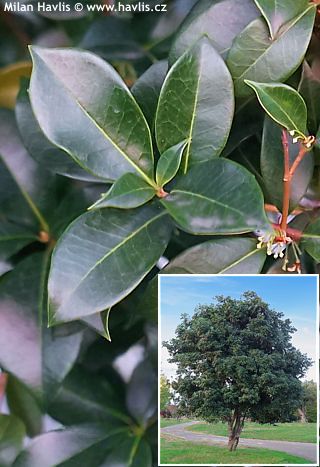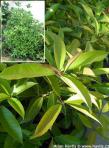Osmanthus fragrans

Osmanthus fragrans
Fragrant olive, sweet olive, sweet tea
Fragrant olive, sweet olive, sweet tea
| SIZE/TYPE | taller shrub |
|---|---|
| small tree | |
| USUAL HEIGHT | 3-4m |
| USUAL WIDTH | 2-3m |
| LEAVES | evergreen broadleaf |
| COLOUR OF LEAVES |
 green green |
| FLOWERS | less showy but noticeable |
| COLOUR OF FLOWERS |
 cream cream
|
| BLOOMING TIME | October - November |
| LOCATION | full to partial sun |
| SOIL TYPE | acidic (peaty) to neutral |
| SOIL MOISTURE REQUIREMENTS | evenly moist but well-drained |
| USDA zone (lowest) | 7 (down to -18°C) |
| WINTER PROTECTION | |
| FOR ZONE 5+6 |

|
| FOR ZONE 7 |

|
| BELONGS TO CATEGORIES |
Evergreen broadleaf Exotics |
Osmanthus is a genus of only about 15-20 evergreen species and varieties, and a genus which I fell in love with the first time I saw a few plants of. Their leathery and sometimes spiny leaves resemble hollies but osmanthus plants have something extra which gave them their name derived from Greek: osme = fragrance and anthos = flower. Osmanthus has tiny but highly fragrant flowers. I was an amateur when I bought the first plants and I had no idea that in all encyclopedias they were rated too tender for our C.E. climate. And since I never knew I put them to my garden. And after some 15 years of growing I can assure you that all of them not only survived even the worst winter of 2006/2007, they thrive and some of them are taller than me and I am very close to 2m. Including the most tender one o.fragrans. I keep on trialling more species and varieties because I noticed that they have some genetic predisposition for extreme drought tolerance in summer and some are even happy with dry soil in winter. And with current lack of precipitation, we will need more of drought-tolerant plants.
The species of sweet olive is an evergreen shrub from Asia where it occupies a wide area from the western Himalayas to Indochina, and among the large-leaved sweet olive species it stands out with one important feature – it has perfectly smooth (entire) leaf margins without a single prickle. Only leaves on young plants may be gently serrated. The leaves are evergreen, oval to broadly elliptic, slightly undulated, leathery, medium to dark green, partially glossy, and decorated with fine veining. Young leaves emerge with handsome maroon hues. It blooms profusely from the very end of the growing season, usually from early October until the frosts, providing the last feast of bee-food. Individual flowers are tiny, creamy white, strongly and sweetly scented.
It grows into a medium-sized to large, upright shrub with smooth, gray branches. With age, its shape gets more rounded, forming a widely oval habit. It can be pruned or trimmed in any way, preferably in the spring after frost. Summer trimming is not recommended due to presence of late summer flower buds. Use it as a unique specimen shrub, in a mixed bed, or in an evergreen hedge combined with other evergreen shrubs of different features. Sweet olive is a long-lived shrub or small tree, a specimen is known to have lived for over 1200 years.
Grow osmanthus in moist but well-drained, humus rich, preferably acidic soil. Provide plenty of mulch for winter to protect the roots from fast freezing. It loves full sun but in colder regions find it a location sheltered from late winter and early spring sunlight but with plenty of light during the growing season. Use only plants with mature wood in zone 7 and transplant it no later than late summer in order to avoid frost damage after the first winter. Soi far we have tested its hardiness down to -17 °C without significant damage (USDA zone 7), only with some sunscorch after its first winter. Further trials continue. Young plants with immature wood must overwinter indoors until they have hardened up. Sweet olive does not suffer from diseases, but vine weevil can be a problem.
Last update 05-02-2024
The species of sweet olive is an evergreen shrub from Asia where it occupies a wide area from the western Himalayas to Indochina, and among the large-leaved sweet olive species it stands out with one important feature – it has perfectly smooth (entire) leaf margins without a single prickle. Only leaves on young plants may be gently serrated. The leaves are evergreen, oval to broadly elliptic, slightly undulated, leathery, medium to dark green, partially glossy, and decorated with fine veining. Young leaves emerge with handsome maroon hues. It blooms profusely from the very end of the growing season, usually from early October until the frosts, providing the last feast of bee-food. Individual flowers are tiny, creamy white, strongly and sweetly scented.
It grows into a medium-sized to large, upright shrub with smooth, gray branches. With age, its shape gets more rounded, forming a widely oval habit. It can be pruned or trimmed in any way, preferably in the spring after frost. Summer trimming is not recommended due to presence of late summer flower buds. Use it as a unique specimen shrub, in a mixed bed, or in an evergreen hedge combined with other evergreen shrubs of different features. Sweet olive is a long-lived shrub or small tree, a specimen is known to have lived for over 1200 years.
Grow osmanthus in moist but well-drained, humus rich, preferably acidic soil. Provide plenty of mulch for winter to protect the roots from fast freezing. It loves full sun but in colder regions find it a location sheltered from late winter and early spring sunlight but with plenty of light during the growing season. Use only plants with mature wood in zone 7 and transplant it no later than late summer in order to avoid frost damage after the first winter. Soi far we have tested its hardiness down to -17 °C without significant damage (USDA zone 7), only with some sunscorch after its first winter. Further trials continue. Young plants with immature wood must overwinter indoors until they have hardened up. Sweet olive does not suffer from diseases, but vine weevil can be a problem.
Last update 05-02-2024
SIZES and PRICES
CURRENTLY SOLD OUT
GLOSSARY
|












